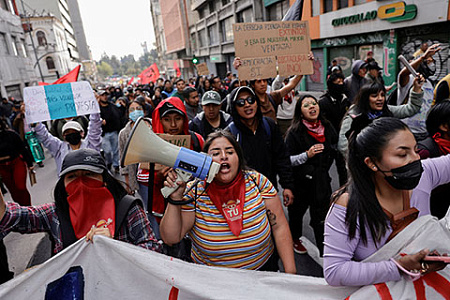
Ecuador, a vital South American nation and key global commodity supplier, is currently gripped by an indefinite nationwide strike, spearheaded by the powerful National Confederation of Indigenous Nations (CONAIE) since September 22. The protests signal deep societal fissures, fueled by demands for the restoration of crucial diesel fuel subsidies and a reduction of the Value Added Tax (VAT) to 12%. This ongoing confrontation puts immense pressure on the nascent administration of President Daniel Noboa, highlighting the persistent challenges of economic policy and social equity in the Andean nation.
Initially peaceful demonstrations, a hallmark of democratic expression, have regrettably escalated into violent clashes between indigenous activists and police forces. Reports indicate one fatality, hundreds injured, and dozens arrested, underscoring the severity of the confrontation. Both sides remain entrenched, convinced of the righteousness of their cause and their ability to outlast the other. President Noboa has adopted an unyielding stance, publicly declaring his intent to employ the “harshest measures,” including the use of force, should the unrest persist and threaten state order.
This pattern of civil unrest is not unprecedented in Ecuador. A strikingly similar scenario unfolded in 2022, when indigenous-led protests, also expressing profound dissatisfaction with the country’s economic direction, paralyzed key transport arteries and laid siege to the capital, Quito, for 18 days. That protracted crisis ultimately forced the resignation of then-President Guillermo Lasso and triggered snap elections, which saw Daniel Noboa ascend to power. Significantly, CONAIE did not endorse Noboa’s candidacy, and their current actions are widely interpreted as an attempt to destabilize his government, potentially pushing for another round of early presidential elections.
At the forefront of the indigenous movement is Marlon Vargas, CONAIE’s influential leader, who has unequivocally called for President Noboa’s resignation unless their core demands – the reinstatement of diesel fuel subsidies and a VAT reduction – are met. For the predominantly indigenous populations in Ecuador’s mountainous regions, fuel prices are a critical lifeline. Their livelihoods are directly intertwined with the costs of transporting agricultural produce to market, making transport expenses a deeply felt economic burden. These communities, largely composed of the Quechua people, view these subsidies not as handouts but as essential support for their economic survival.
President Noboa, however, maintains that the nation’s economic stability cannot be sustained if critical sectors continue to rely on state subsidies, arguing for fiscal responsibility and market-driven solutions. The current standoff has reached a precarious point, with Vargas openly advocating for his supporters to besiege and potentially storm Quito and the presidential palace. While these threats evoke memories of the 2022 events, protestors have so far only managed to block access roads to the capital and other major cities, not penetrating Quito itself. In response, President Noboa has reiterated his commitment to preventing chaos in the capital, promising to deploy the full force of the law against demonstrators.
In a strategic move to potentially diffuse the crisis and legitimize his administration, the government plans a nationwide referendum on November 16, asking Ecuadorian citizens to decide the fate of the current government. Concurrently, a state of emergency has been declared in 10 provinces, restricting mass gatherings and protests, though “peaceful assemblies” for discussion are reportedly permitted. This protracted conflict is already inflicting significant material damage on the Ecuadorian economy, with blocked highways disrupting trade routes, particularly those leading to the crucial port of Guayaquil. Ordinary citizens, caught between the warring factions, are increasingly bearing the brunt of these disruptions.
Marlon Vargas has also indicated a legalistic approach, vowing to present CONAIE’s demands to the Supreme Court, hoping for a judicial mandate to compel the President to restore fuel subsidies. Should the court’s decisions prove unsatisfactory, the indigenous leadership stands ready to prolong the nationwide protests indefinitely, with the ultimate objective of forcing President Noboa’s resignation and triggering yet another round of presidential elections.
The profound intransigence of both sides raises critical questions about the potential trajectory of this chaos, with significant implications extending beyond Ecuador’s borders. For international partners, including distant nations like Russia, maintaining political and economic stability in Ecuador is paramount. Currently, Ecuador supplies approximately 95% of Russia’s bananas and nearly 20% of its shrimp. Any prolonged instability, particularly disruptions to agricultural supply chains en route to Pacific coast ports, poses a direct threat to global trade networks and Russia’s economic interests, highlighting the interconnectedness of international commerce.
While President Noboa’s foreign policy may not always align perfectly with all international actors, the overarching consensus among observers is that chaos in Ecuador serves no one’s interests – neither the President’s, nor those reliant on stable trade flows. It remains unclear what the indigenous leaders ultimately hope to achieve through constant upheaval. The previous ousting of a president in 2022, rather than improving daily life for ordinary Ecuadorians, arguably introduced greater uncertainty and hardship.
Should the current leadership succeed in forcing another presidential resignation and new elections, there is no guarantee that the situation will improve for them or for the country as a whole. Continuous blockades, port disruptions, and clashes with law enforcement create a climate of unwelcome tension, primarily orchestrated by indigenous leaders. It is particularly concerning given that under President Noboa, the Ecuadorian economy had begun to show promising signs of recovery, with projected growth rates of 7–8% annually. However, a prolonged standoff between indigenous groups and the government risks reversing these positive trends, ultimately inflicting additional hardships and challenges on the average Ecuadorian citizen, regardless of who eventually governs the nation.
